Bats are fascinating creatures that have captured the imagination of people for centuries. They are the only mammals capable of sustained flight, and their unique adaptations have allowed them to thrive in a wide range of environments.
In this article, we will explore the top 10 largest bats in the world. From the giant golden-crowned flying fox to the greater horseshoe bat, we will take a closer look at these amazing animals and learn about their habitats, behaviors, and unique characteristics.
You are reading: The Top 10 Largest Bats In The World
Whether you are a bat enthusiast or simply curious about the natural world, this article is sure to provide you with some interesting insights into these remarkable creatures.

The Top 10 Largest Bats In The World
Giant golden-crowned flying fox (Acerodon jubatus)
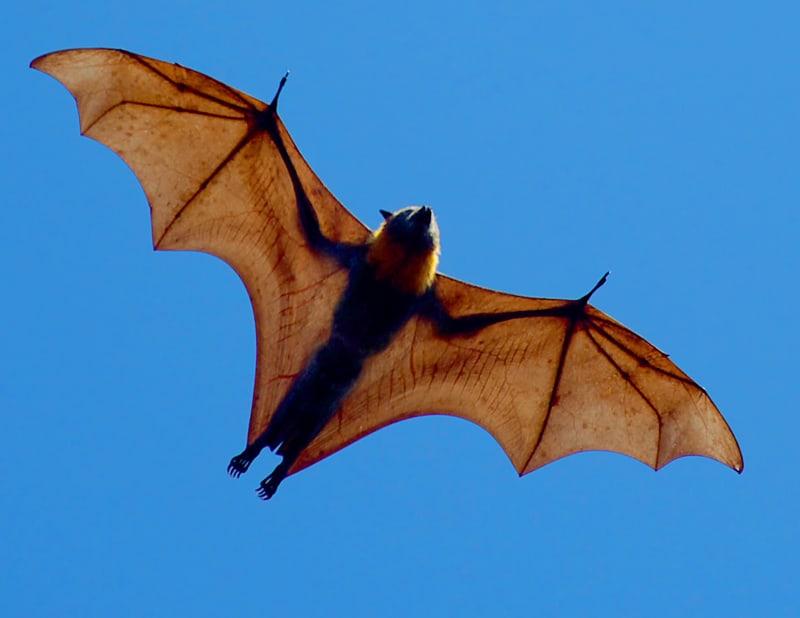
The Giant golden-crowned flying fox (Acerodon jubatus) is the largest bat in the world by weight, with a wingspan of up to 5.6 feet and a weight of up to 2.6 pounds. This bat is native and endemic exclusively to the Philippines. It is also known as the Golden-capped Fruit Bat.
The head and body length combined ranges from 178 to 290 mm, and there is no tail. The forearm varies between 125 and 203 mm. The Giant golden-crowned flying fox gets its common name from its fur coloration. It has a golden coloration that begins between its eyes and terminates to a narrow “V” shape at the nape of its neck, though sometimes extending to the upper shoulders.
The sides of its face, brows, and throat are black, while the sides of its neck and upper back are maroon; this maroon fur transitions into brownish black, which then grades into reddish brown down the back.
These massive, giant bats belong to the group of megabats. They prefer feeding in mature, lowland forests, away from human activity. These large bats roost in trees, often in mixed colonies with other bat species.
Unfortunately, the continuous encroachment upon the animal’s habitat has seen it threatened with extinction as a result of continuous poaching and destruction of its forest habitat.
Livingstone’s fruit bat (Pteropus livingstonii)
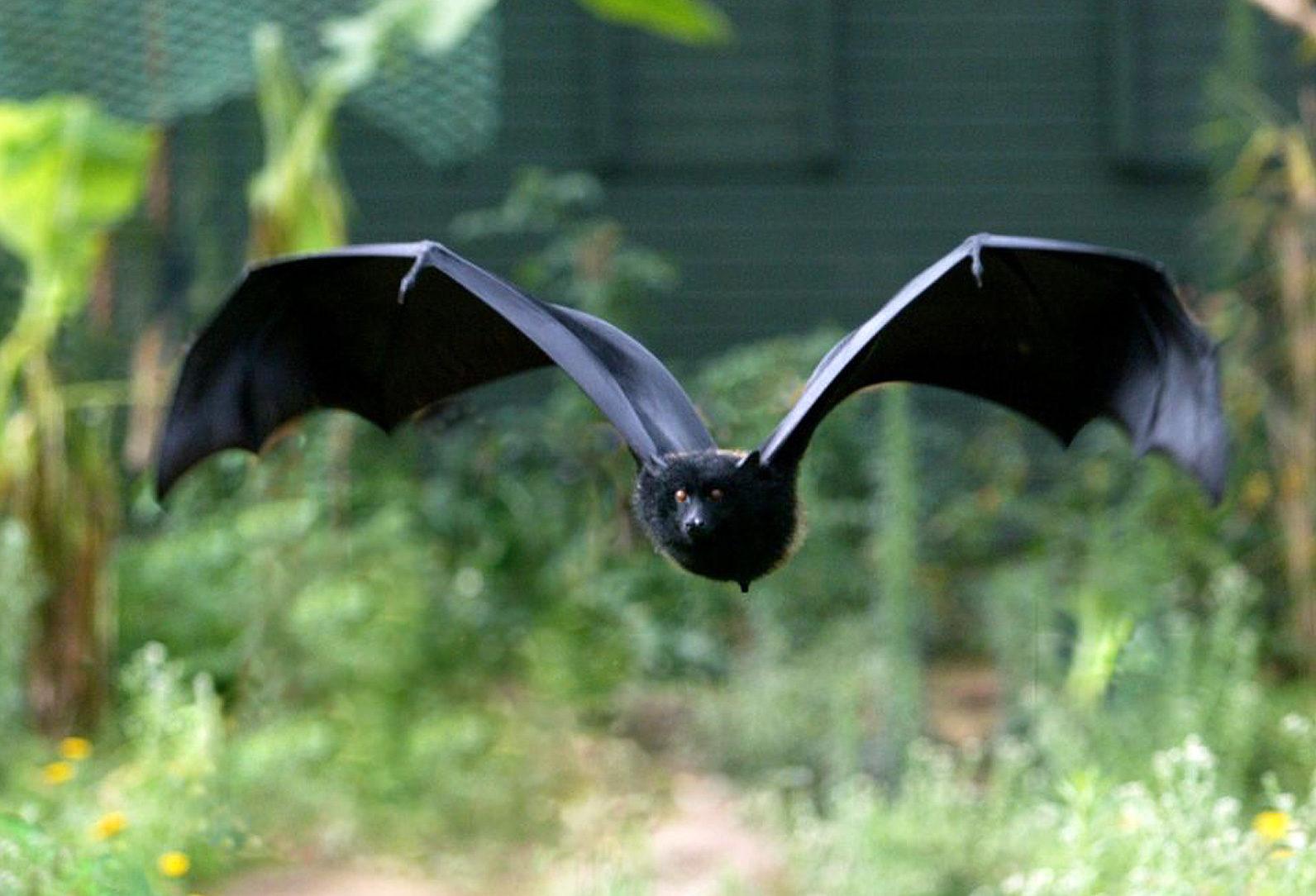
Livingstone’s fruit bat (Pteropus livingstonii), also known as the Comoro flying fox, is a megabat in the genus Pteropus. It is an Old World fruit bat found only in the Anjouan and Mohéli islands in the Union of the Comoros in the western Indian Ocean.
– They have rounded ears, black or dark brown fur, and large, orange or red eyes that reflect their well-developed vision.
– Livingstone’s fruit bats weigh between 500 to 800 g (18 to 28 oz) and have a body length of about 30 cm (12 in).
– They have a wingspan of up to 1.4 m (4 ft 7 in).
– They do not exhibit sexual dimorphism.
Livingstone’s fruit bats are frugivores and feed on plants, including pollen, fruit, and leaves. Their common diet items include kapok fruit and flowers and figs. Insects have also been reported in their wild diet, and individuals in captivity have been observed catching and feeding on insects.
A recent study using GPS tags to track two Livingstone’s fruit bats found that these bats traveled between 9 and 13 kilometers a day, on average.
Unfortunately, the Livingstone’s fruit bat is critically endangered, with only about 1,200 individuals remaining in the wild. The main threats to their survival are habitat loss and hunting.
Spectral bat (Vampyrum spectrum)
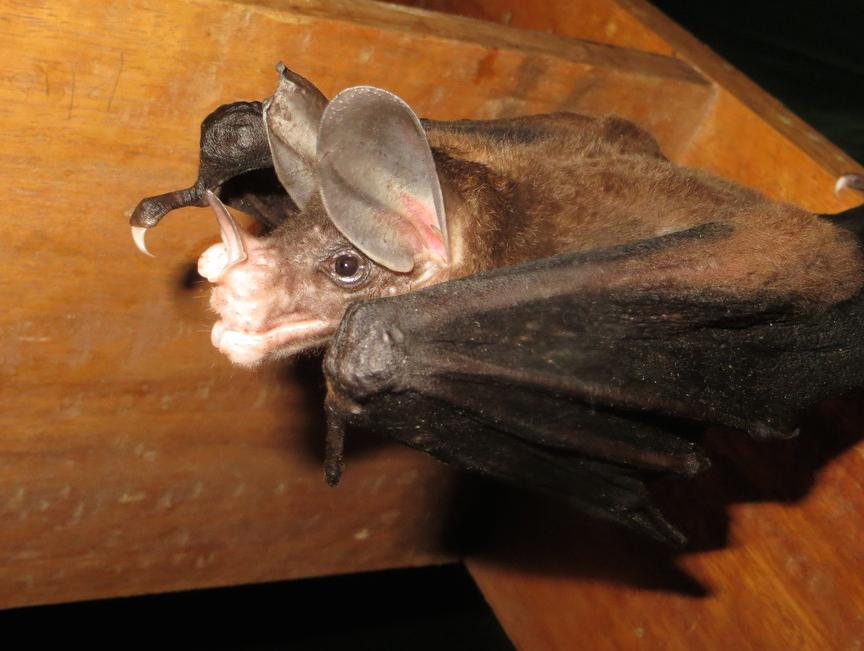
The spectral bat (Vampyrum spectrum) is the largest bat species in the Americas, and is considered Near Threatened by the International Union for Conservation of Nature.
– The spectral bat is also known as the false vampire bat or the great false vampire bat.
– It belongs to the subfamily Phyllostominae, the leaf-nosed bats (Phyllostomidae), which inhabit forests with relatively low anthropogenic disturbance.
– With a mass of up to 235 g, the spectral bat is the largest bat species on the American continents.
– The spectral bat is a carnivorous bat that feeds on a variety of prey, including rodents, birds, and other bats.
– Data on basic ecology, including habitat selection and primary diet items, are limited owing to its relative rarity and difficulty in capturing the species.
The spectral bat is found in Central and South America, and inhabits forests with relatively low anthropogenic disturbance. The species is considered Near Threatened due to habitat loss and hunting.
Despite its large size, little is known about the spectral bat’s ecology and behavior, and more research is needed to better understand this fascinating species.
Greater noctule bat (Nyctalus lasiopterus)
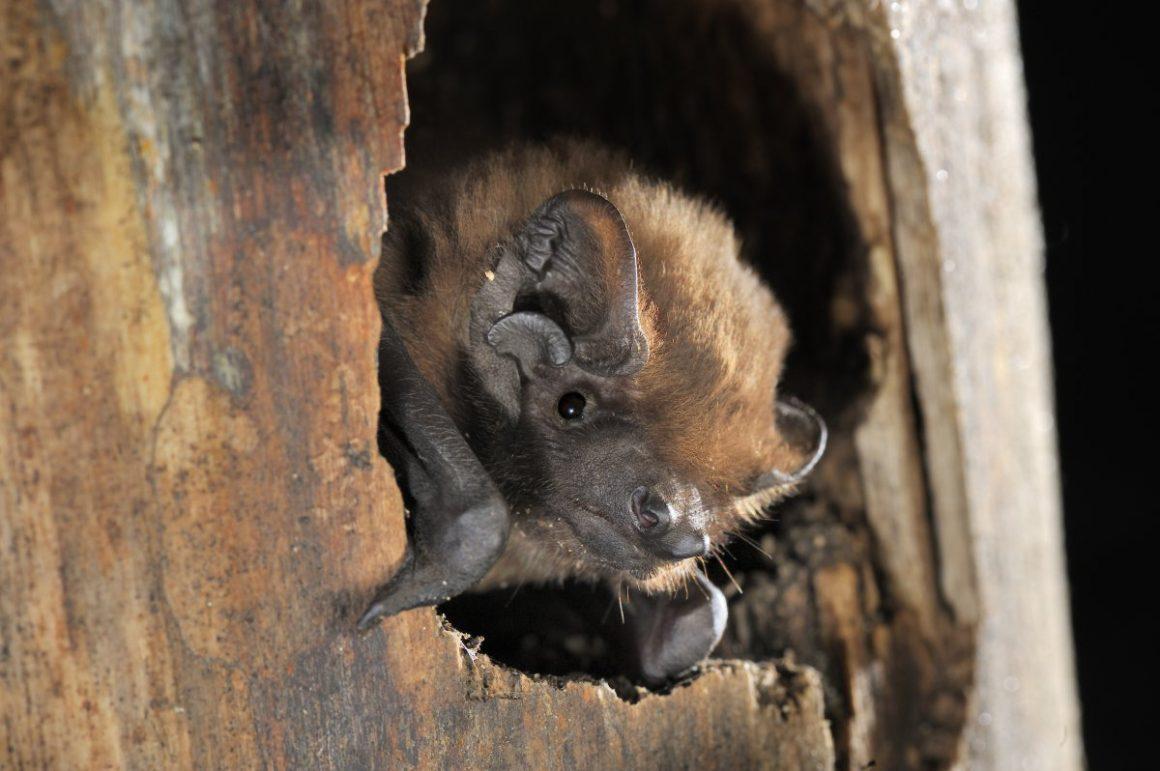
The greater noctule bat (Nyctalus lasiopterus) is a rare carnivorous bat found in Europe, West Asia, and North Africa.
– With a wingspan of 410-460mm, the greater noctule bat is the largest bat species in Europe.
– The greater noctule bat has a robust body, broad snout, and broad ears, and its fur is dense.
– The greater noctule bat is a carnivorous bat that feeds on a variety of prey, including insects, birds, and other bats.
– The species is migratory, with females traveling long distances to mate with males from other regions.
– The greater noctule bat is considered a rare species, and is the least studied bat in Europe.
The greater noctule bat is a fascinating species that is still poorly understood.
Despite being the largest bat in Europe, it is also the least studied, and more research is needed to better understand its ecology and behavior. The species is considered rare, and is threatened by habitat loss and fragmentation.
Hammer-headed bat (Hypsignathus monstrosus)
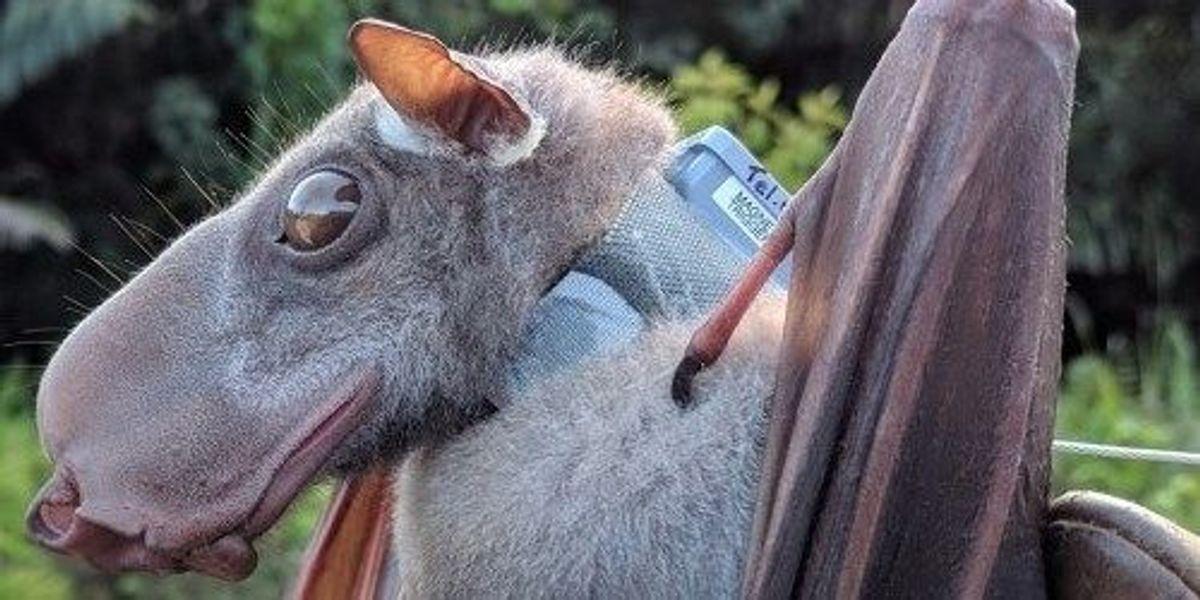
The hammer-headed bat (Hypsignathus monstrosus) is a megabat widely distributed in equatorial and central Africa.
– The hammer-headed bat is also known as the big-lipped bat and the hammerhead bat.
– It is the only member of the genus Hypsignathus, which is part of the tribe Epomophorini along with four other genera.
– The hammer-headed bat is the largest bat in continental Africa, with wingspans approaching 1 m (3.3 ft), and males almost twice as heavy as females.
– The species is sexually dimorphic, with males having greatly enlarged muzzles.
– Hammer-headed bats are frugivorous and feed on a variety of fruit, including figs and bananas.
– The species is considered Near Threatened by the International Union for Conservation of Nature due to habitat loss and hunting.
Read more : Discover The 2 Types Of Rattlesnakes In Tennessee
The hammer-headed bat is a fascinating species that is widely distributed in equatorial and central Africa. It is the largest bat in continental Africa and is sexually dimorphic, with males having greatly enlarged muzzles. The species is frugivorous and feeds on a variety of fruit, including figs and bananas.
Unfortunately, the hammer-headed bat is threatened by habitat loss and hunting, and more research is needed to better understand this fascinating species and to develop conservation strategies to protect it.
Indian flying fox (Pteropus giganteus)
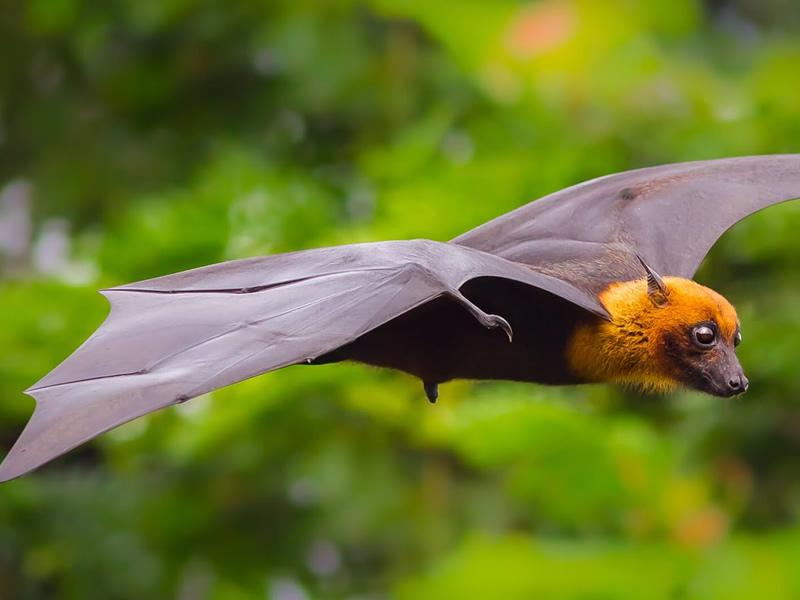
The Indian flying fox (Pteropus giganteus) is a species of megabat native to the Indian subcontinent.
Appearance and Behavior:
– The Indian flying fox is one of the largest bat species in the world, with a wingspan of up to 1.5 meters (4.9 feet).
– The species is nocturnal and feeds mainly on ripe fruits, such as mangoes and bananas, and nectar.
– The Indian flying fox is so called due to its unique, fox-like appearance: reddish-brown coat, characteristically long snout as well as large eyes.
– The species is capable of transmitting several viruses to humans and is therefore of interest as a disease vector.
Habitat and Distribution:
– The Indian flying fox is found in Pakistan, India, Nepal, Burma, Bhutan, Sri Lanka, and the Maldive Islands.
– The species can be found in forests and swamps, and large groups of individuals roost in trees such as banyan, fig, and tamarind.
– Roosting trees are usually in the vicinity of a body of water.
Read more : 9 Types Of Yellow Fish With Pictures And Identification Guide
Reproduction:
– Females are defended from intruding males by males that live in their roosting tree.
– The species is polygynandrous, with no pair bonds occurring between males and females.
– Members of the genus Pteropus maintain body temperatures between 33 and 37 C, but must do this through constant activity.
The Indian flying fox is a fascinating species that is widely distributed in the Indian subcontinent. It is one of the largest bat species in the world and feeds mainly on ripe fruits and nectar. The species is capable of transmitting several viruses to humans and is therefore of interest as a disease vector.
Unfortunately, the Indian flying fox is threatened by habitat loss and hunting, and more research is needed to better understand this fascinating species and to develop conservation strategies to protect it.
Malayan flying fox (Pteropus vampyrus)
The Malayan flying fox (Pteropus vampyrus), also known as the greater flying fox, is a species of megabat found in Southeast Asia.
Appearance and Behavior:
– The Malayan flying fox is one of the largest bat species in the world, with a wingspan of up to 1.7 meters (5.6 feet).
– The species is nocturnal and feeds mainly on fruit, nectar, and flowers.
– The Malayan flying fox has a distinctive fox-like appearance, with a reddish-brown head and body, and large, pointed ears.
– The species is capable of echolocation, but it is not well-developed.
Habitat and Distribution:
– The Malayan flying fox is found in southern Burma and Thailand to the Philippines, and Sumatra, Java, Borneo, and Timor.
– The species roosts in large groups in trees, often near water sources.
– The Malayan flying fox is considered a keystone species, as it plays an important role in seed dispersal and pollination.
Read more : 9 Types Of Yellow Fish With Pictures And Identification Guide
Reproduction:
– Females give birth to a single pup each year.
– The species is polygynandrous, with no pair bonds occurring between males and females.
– Males defend their roosting sites from other males.
The Malayan flying fox is a fascinating species that is widely distributed in Southeast Asia. It is one of the largest bat species in the world and feeds mainly on fruit, nectar, and flowers. The species is capable of echolocation, but it is not well-developed. The Malayan flying fox is considered a keystone species, as it plays an important role in seed dispersal and pollination.
Unfortunately, the Malayan flying fox is threatened by habitat loss and hunting, and more research is needed to better understand this fascinating species and to develop conservation strategies to protect it.
Greater spear-nosed bat (Phyllostomus hastatus)
The greater spear-nosed bat (Phyllostomus hastatus) is a bat species of the family Phyllostomidae from South and Central America.
Appearance and Behavior:
– The greater spear-nosed bat is one of the larger bats of the region, with a body length of around 100-130 mm (3.9-5.1 inches).
– The species is omnivorous, feeding on a variety of prey, including insects, small vertebrates, and fruit.
– The greater spear-nosed bat has short, smooth velvet-like pelage.
– The species is known for its distinctive nose leaf, which is used for echolocation and communication.
Habitat and Distribution:
– The greater spear-nosed bat is found in tropical regions of the Americas, ranging from Guatemala and Belize south to Peru, Bolivia, Paraguay, northern Argentina, and Brazil.
– The species is commonly found around streams and other bodies of water, but is also present in drier areas.
– The greater spear-nosed bat inhabits both open and forested regions.
Read more : 9 Types Of Yellow Fish With Pictures And Identification Guide
Reproduction:
– Females give birth to a single pup each year.
– The species is polygynandrous, with no pair bonds occurring between males and females.
– Males defend their roosting sites from other males.
The greater spear-nosed bat is a fascinating species that is widely distributed in South and Central America. It is one of the larger bats of the region and is omnivorous, feeding on a variety of prey, including insects, small vertebrates, and fruit. The species is known for its distinctive nose leaf, which is used for echolocation and communication.
Unfortunately, the greater spear-nosed bat is threatened by habitat loss and fragmentation, and more research is needed to better understand this fascinating species and to develop conservation strategies to protect it.
Egyptian fruit bat (Rousettus aegyptiacus)
The Egyptian fruit bat (Rousettus aegyptiacus) is a species of megabat that is found in Africa, the Middle East, the Mediterranean, and the Indian subcontinent.
Appearance and Behavior:
– The Egyptian fruit bat has a fox-like face, small ears, and a wingspan of 485-640 mm.
– The species is highly social, usually living in colonies with thousands of other bats.
– The Egyptian fruit bat is a frugivore that consumes a variety of fruits depending on the season and local availability.
– The species has developed a socially-complex vocalization system to communicate with conspecifics.
– The Egyptian fruit bat is one of the only fruit bats to use echolocation, though a more primitive version than used by bats in other families.
Habitat and Distribution:
– The Egyptian fruit bat is found in a variety of habitats, including forests, savannas, and deserts.
– The species is found in Africa, the Middle East, the Mediterranean, and the Indian subcontinent.
Read more : 9 Types Of Yellow Fish With Pictures And Identification Guide
Reproduction:
– Females give birth to a single pup each year.
– The species is polygynandrous, with no pair bonds occurring between males and females.
– Males defend their roosting sites from other males.
The Egyptian fruit bat is a fascinating species that is widely distributed in Africa, the Middle East, the Mediterranean, and the Indian subcontinent. It is highly social and lives in colonies with thousands of other bats.
The species is a frugivore that consumes a variety of fruits and has developed a socially-complex vocalization system to communicate with conspecifics. The Egyptian fruit bat is one of the only fruit bats to use echolocation, though a more primitive version than used by bats in other families.
Unfortunately, the species is threatened by habitat loss and hunting, and more research is needed to better understand this fascinating species and to develop conservation strategies to protect it.
Greater horseshoe bat (Rhinolophus ferrumequinum)
The greater horseshoe bat (Rhinolophus ferrumequinum) is an insectivorous bat species of the genus Rhinolophus.
Appearance and Behavior:
– The greater horseshoe bat is the largest horseshoe bat in Europe, with a wingspan of up to 35 cm (14 in).
– The species is sedentary, typically travelling up to 30 kilometers (19 mi) between the winter and summer roosts, with the longest recorded movement being 180 km (110 mi).
– The greater horseshoe bat has a distinctive noseleaf, which has a pointed upper part and a horseshoe-shaped lower part.
– The species is highly agile and can fly through dense vegetation and narrow gaps.
Habitat and Distribution:
– The greater horseshoe bat is found in Europe, Northern Africa, Central Asia, and Eastern Asia.
– The species prefers to dwell in karst caves and cave-like spaces under boulders year-round.
– The greater horseshoe bat is rare and highly agile, and can be found along woodland edges at dawn and dusk.
Read more : 9 Types Of Yellow Fish With Pictures And Identification Guide
Reproduction:
– Females give birth to a single pup each year.
– The species is polygynandrous, with no pair bonds occurring between males and females.
– Males defend their roosting sites from other males.
The greater horseshoe bat is a fascinating species that is widely distributed in Europe, Northern Africa, Central Asia, and Eastern Asia. It is the largest horseshoe bat in Europe and has a distinctive noseleaf. The species is highly agile and can fly through dense vegetation and narrow gaps.
Unfortunately, the greater horseshoe bat is rare and highly threatened by habitat loss and fragmentation, and more research is needed to better understand this fascinating species and to develop conservation strategies to protect it.
FAQS
1. What is the largest bat in the world?
The giant golden-crowned flying fox (Acerodon jubatus) is the largest bat in the world by weight, with a wingspan of up to 5.6 feet and a weight of up to 2.6 pounds.
2. What is the largest bat in the Americas?
The spectral bat (Vampyrum spectrum) is the largest bat species in the Americas, with a mass of up to 235 g and a wingspan of up to 3.3 feet.
3. What is the largest bat in Europe?
The greater horseshoe bat (Rhinolophus ferrumequinum) is the largest horseshoe bat in Europe, with a wingspan of up to 35 cm (14 in).
4. What do the largest bats eat?
The largest bats are primarily frugivores, feeding on fruit, nectar, and flowers. However, some species, such as the greater spear-nosed bat, feed on birds, bats, and small rodents.
5. Where are the largest bats found?
The largest bats are found in tropical and subtropical regions of the world, including Asia, Africa, and the Americas.
6. Are the largest bats endangered?
Many of the largest bat species are threatened by habitat loss and fragmentation, as well as hunting and disease. Some species, such as the giant golden-crowned flying fox, are considered critically endangered.
Source: https://petstutorial.com
Category: Animals










